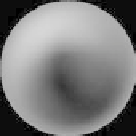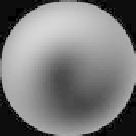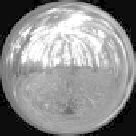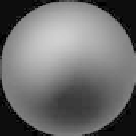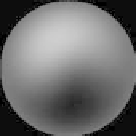Graphics Reference
In-Depth Information
Figure 7.12
Irradiance environment maps. The left column shows the original HDR environment map
rendered onto a sphere. The middle and right columns show the irradiance distribution,
also rendered onto a sphere. The irradiance at each point is that produced on a surface
that “looks up” at the corresponding point in the environment map at the left. The images
in the middle column show the precisely computed irradiance; those at the left show the
nine-term SH approximation. The differences are hardly noticeable. (From [Ramamoorthi
and Hanrahan 01a] c
2001 ACM, Inc. Included here by permission.)
mial (of degree
l
) in three rectangular coordinates. Applying the linear coordinate
transformation to this polynomial effects a change of coordinates. Because the
degree
l
is limited to 2, the irradiance
E
can thus be expressed explicitly as a
quadratic polynomial in
x
,
y
,and
z
with coefficients in terms of the precomputed
L
l
,
m
and
A
l
. Such polynomials are easily computed by hardware pixel shaders; in
fact,
E
(
n
)
(
n
)
can be expressed as a 4
×
4 matrix multiplication—a highly optimized
operation in graphics hardware.
Figure 7.12 illustrates results of Ramamoorthi and Hanrahan's method. The
left column shows the original HDR environment maps used for the experiments.
The middle column shows the irradiance computed by directly integrating the
HDR environment map; the right column shows the result of the quadratic SH
approximation. The irradiance
E
is a function of direction, so the results are
displayed on a sphere to match the representation of the environment map. As
noted in the paper, the average error is less than 1%, and the maximum error is
under 5% for these images. (Under appropriate assumptions, the theoretical error
is at most 9%.)
The primary goal of the method introduced in the “An Efficient Representation
for Irradiance Environment Maps” paper was to make rendering using prefiltered
environment maps more efficient, but the paper has had a wider impact. It had
been known for many years that low frequency illumination, such as diffuse light-
(
n
)








